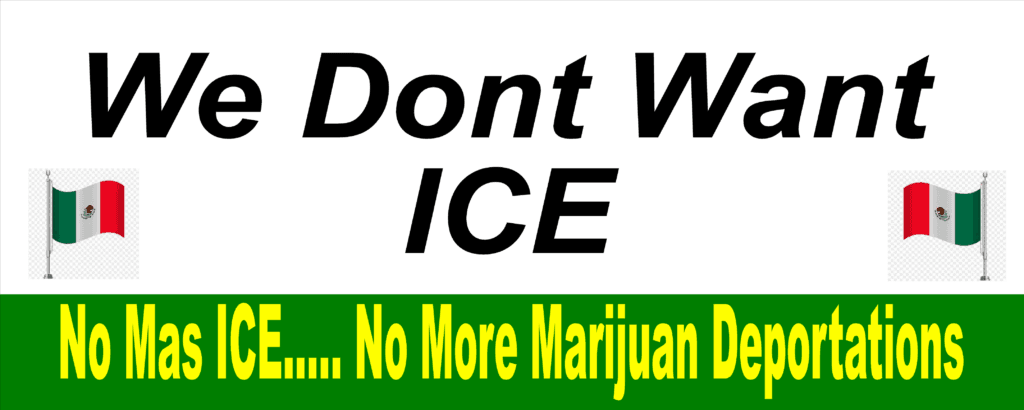LA immigration ICE banners are being used with great success in spreading the word. In June 2025, Los Angeles became the epicenter of a growing national immigration crisis. ICE agents launched coordinated surprise raids across the city, targeting undocumented workers in homes and workplaces.
Major businesses—including Home Depot stores and local garment factories—were raided. So families were separated on the spot, with many detained without prior notice. But these actions immediately sparked widespread protests across neighborhoods like East LA, Boyle Heights, and downtown.
Protesters chanted, carried signs, and demanded an end to aggressive federal immigration enforcement. So tensions escalated as ICE checkpoints appeared near schools and hospitals, drawing sharp criticism from local leaders.
Mayor Karen Bass condemned the raids, calling them unconstitutional and damaging to vulnerable communities. So activists responded rapidly—distributing legal aid information, filming arrests, and organizing grassroots resistance.
Neighborhoods mobilized overnight, with residents forming human chains to block ICE vehicles. So national media arrived within hours, broadcasting scenes of chaos and community defiance. By June 7, the city declared a state of emergency amid growing unrest. But outrage intensified as news spread of children being detained separately from their parents.
LA immigration ICE Banners Become Symbols of Unity
The streets of Los Angeles were soon covered in bold protest banners hanging from buildings, freeways, and overpasses. Messages like “Abolish ICE,” “We Are Not Illegal,” and “Immigrants Make America” dominated the city.
Artists painted powerful visuals of migrant families behind barbed wire, with drones overhead—turning protest art into a rallying cry. Banners mixed Spanish and English, reflecting LA’s bilingual and multicultural identity.
Some banners called for policy change; others directly criticized President Trump and federal law enforcement. So city hall, churches, and schools joined in, draping messages of inclusion from rooftops.
Students marched with handmade posters protesting ICE in their neighborhoods. Each message was powerful, emotional, and deeply personal. Journalists shared these visuals across global media, turning LA into a symbol of resistance.
Digital billboards and light projections brought anti-ICE messages to thousands. Artist workshops taught people to create protest materials. Drawing large crowds and uniting generations under a common cause.
National Guard and Federal Troops Arrive in LA
On June 8, President Trump ordered the deployment of the California National Guard and 700 Marines to Los Angeles. Citing “riots,” he claimed federal intervention was necessary to restore order.
The move sparked immediate controversy. California Governor Gavin Newsom opposed the deployment, calling it both illegal and unnecessary. He filed a lawsuit accusing the federal government of violating state control over public safety.
Despite legal pushback, federal troops remained and soon clashed with demonstrators in downtown LA. So protesters chanted against the military presence and equipped themselves with helmets, face masks, and goggles.
Skirmishes near Staples Center and Pershing Square escalated, with tear gas and rubber bullets used against crowds. Community medics treated the wounded behind protest lines while legal observers documented arrests and filed complaints.
Federal troops restricted access to key areas and imposed curfews. Critics likened the situation to an “occupation,” and by mid-June, over 800 people had been arrested. But more than a dozen lawsuits were filed over excessive force and civil rights violations.
Nationwide Solidarity and Legal Pushback
The events in LA quickly inspired protests in cities across the United States. Solidarity marches erupted in San Francisco, Chicago, New York, and dozens of other cities.
The “No Kings” movement emerged, protesting what activists called authoritarian immigration policies. Banners and slogans from LA were echoed nationwide. Hashtags like #AbolishICE, #FreeOurFamilies, and #NoKings trended for weeks.
Several states joined California’s legal challenge to the federal troop deployment. So civil rights groups filed supporting briefs, and protesters called on Congress to defund ICE and invest in community-based alternatives.
Emergency hearings in the Senate addressed allegations of abuse inside federal detention centers. Public figures—including celebrities, athletes, and tech leaders—spoke out, amplifying public pressure.
Universities and major companies saw mass walkouts in support of immigrant families. The ACLU launched a campaign to track and report civil rights violations. But faith communities opened their doors as sanctuaries for those fearing arrest.
Rallies, vigils, and teach-ins were held nationwide, demanding real immigration reform. By late June, immigration policy had become one of the central issues in the 2025 election cycle.
The Aftermath and the Road Ahead
Three weeks into the unrest, protests continued throughout Los Angeles and beyond. So many families remained separated, with loved ones still held in ICE detention.
Activists vowed to keep up the pressure until substantial immigration reforms were passed. Lawyers continued fighting for the humane treatment and release of detainees. But mental health professionals reported trauma spreading through immigrant neighborhoods—especially among children.
Local schools organized healing workshops and support circles. The protest banners, once draped across LA’s skyline, were collected and archived in museums as symbols of unity and resistance.
The LA City Council passed new resolutions reaffirming sanctuary policies and prohibiting cooperation with ICE. So multiple lawsuits over the legality of federal troop deployments were still pending in court.
While immigration reform bills gained traction in the House, Senate opposition remained strong. But still, organizers expressed hope—citing increased public support and momentum.
Community groups kept the cause alive through digital campaigns, art exhibits, and public events. So the spirit of June 2025 remains a symbol of resistance and resilience in the ongoing movement for immigrant rights.
Los Angeles stood firm. Through art, activism, and unity, the city challenged injustice—and the world took notice.

